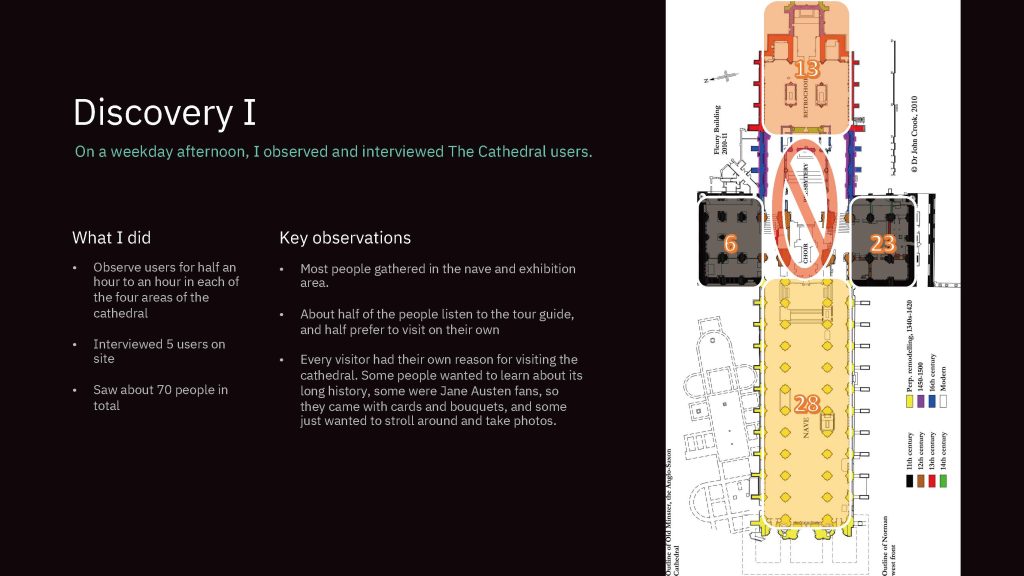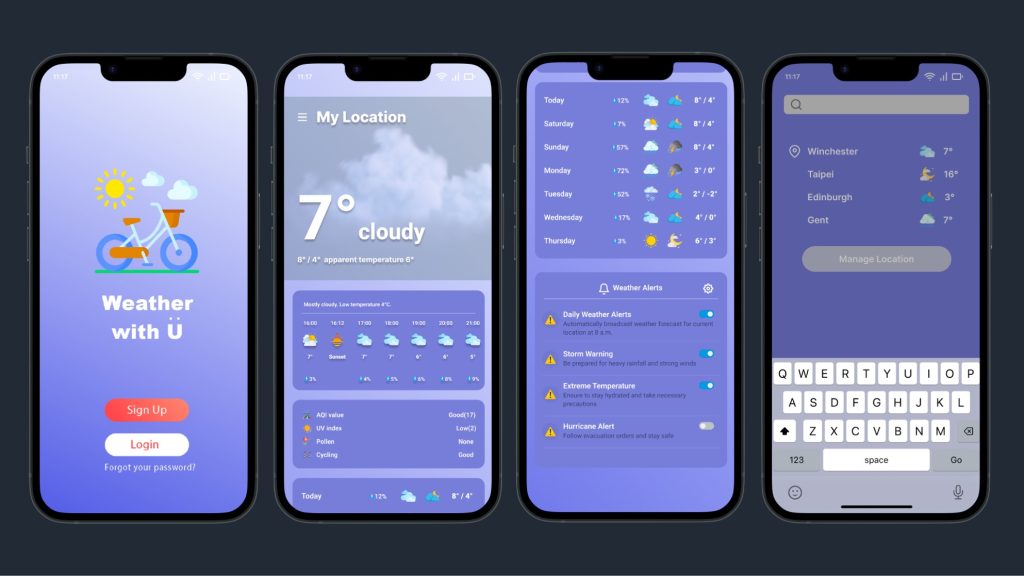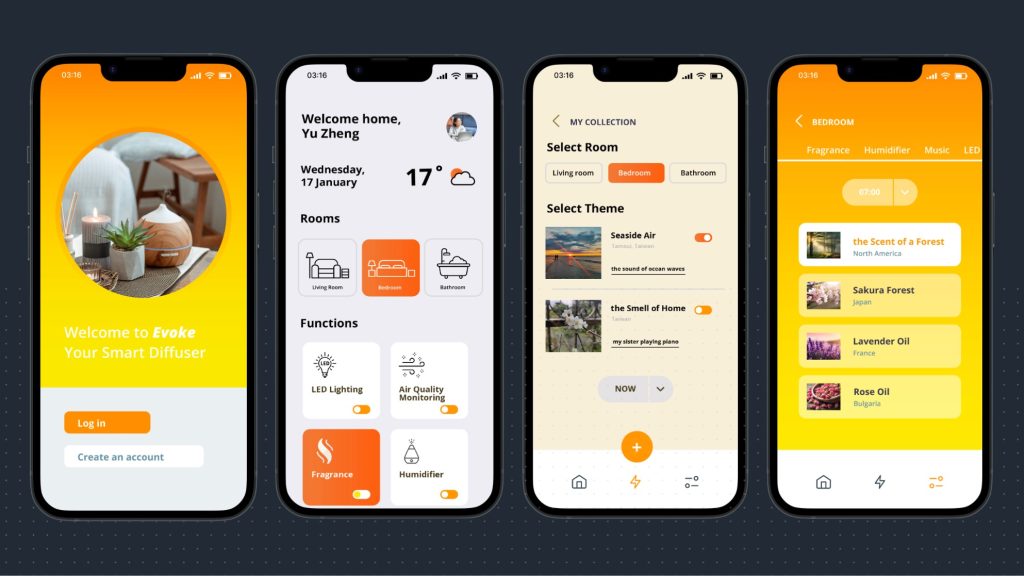
D – Describe objectively what I learned
This semester has been a transformative journey for me, transitioning from a background in chemistry to immersing myself in the world of interactive design. The insights gained were vast and impactful. Learning user-centered design methods and the iterative design process has opened new avenues for my future endeavors. Initially, unfamiliar with design terminology and concepts, I can now confidently navigate and apply them, bridging the gap between theoretical understanding and real-world design scenarios.
In Project 1, I applied the 5C design process model, focusing on COLLECT and COMPREHEND elements. People watching in Winchester Cathedral provided valuable insights into user behavior and interaction. The diverse research methods, including interviews and surveys, expanded my understanding of real-world applications of design. This project extended my design concepts from two-dimensional to three-dimensional, broadening my perspective on interactive experience design.

In the second blog task, I formulated a personal mini-Manifesto to elucidate my aspirations and principles as a designer, as well as to outline strategies for capturing and fostering inspiration. While executing project 2, I opted to delve into the theme of addressing technology overuse, actively applying creativity-generating methods acquired in the classroom. I envisioned diverse creative solutions, ultimately narrowing down to two ideas for in-depth discussion and research. This process of nurturing ideas to thrive has been a valuable learning experience.
During the execution of Project 3, I gained valuable experience in designing a mobile application called “Weather With Ü” specifically tailored for cyclists and motorcycle commuters. Initially, I utilized the PACT analysis method to comprehend the target audience and establish user personas, which served as a guiding framework throughout the entire design process. After defining the project objectives and content, I generated a series of digital prototypes. These prototypes played a crucial role in conducting user testing for the app design, ensuring alignment with specified requirements, and garnering valuable user feedback for future enhancements. Throughout this endeavor, I acquired proficiency in the key design tool Figma, and successfully created my first digital prototype of an application.

The iterative design process became the cornerstone of my learning experience, preparing me for Project 4 and becoming more proficient in leveraging skills and tools to create a more comprehensive and innovative application.
Embarking on Project 4, I applied a similar research methodology, elevating the project to new heights. My familiarity with the PACT analysis method and prototyping tools enabled a more focused approach to ideation and execution, allowing me to seamlessly integrate the knowledge acquired in this module and present a more refined final product. Reflecting on the transition from Project 3 to 4, I had a sense of accomplishment in witnessing my growth on the design path.

I – Interpret the insight
Project 1 revealed the profound connection between design and our daily lives. Winchester Cathedral served as a case study, illustrating the diverse motivations of visitors and the positive impact of thoughtful design on their experiences. It became evident that design has the potential to enhance people’s lives in meaningful ways. These insights highlighted the significance of context-aware and inclusive design in creating meaningful user experiences.
In the execution of the Project 2, the embodiment of the creative process unfolded. Focusing on the theme “Being Human,” I generated concepts like technology-free public areas and digital detox resorts, emphasizing the need for balance in our tech-driven lives. At the same time, I also try to come up with bolder ideas, integrating technology into the design of antidote to overuse of technology. This involves creating an immersive AR interactive exhibition centered around plants, showcasing the potential of technology to in promoting connection with nature and raising ecological awareness. Transitioning from unconventional ideas to expressing concepts through visuals, I recognized the potency of visual imagery. Reflecting on the project, if given another opportunity, I aspire to create more comprehensive conceptual works and experiment with diverse hand-drawn methods of visual communication.
Moreover, while engaging in various blog tasks, I am appreciative of the opportunity to acquire and assimilate crucial design concepts, methods, and knowledge, including Affordances, Human-Centered Design, and more. The concept of Norman doors, as introduced by design expert Don Norman, triggered my reflections on various design principles tied to daily habits. This experience facilitated an intuitive and swift grasp of what constitutes “good” design and the significance of incorporating affordances in design practices. In addition, delving into a series of prototyping videos during blog task 3 proved instrumental in preparing for projects 3 and 4. This exploration facilitated a clear understanding of diverse prototyping methods, stages, and their significance and value.
Projects 3 and 4 served as a platform for me to integrate the acquired knowledge throughout the module by practically building an application. These projects also taught me the significance of PACT analysis and user testing. The iterative design process, coupled with valuable user feedback, enabled me to pinpoint areas for enhancement. I look forward to employing these methodologies more extensively in the future to refine the user experience.
Embarking on these projects and documenting my insights in blogs has deepened my understanding that design is intricately connected to every facet of our lives. It has illuminated the transformative potential of design in making people’s daily lives more ideal.
E – Evaluate what I have learned
The value of these insights is immense. Acquiring a grasp of user-centered design and the iterative process has not only elevated my design skills but has also transformed my approach to problem-solving. The practical application of theoretical concepts in real-world scenarios significantly enhanced my understanding of interactive design. Notably, concepts like affordances and human-centered design became crucial tools in creating effective and pleasurable designs. The ability to conduct diverse research methods, from interviews to usability testing, contributed to meaningful insights and informed decision-making. The prototyping series and the valuable takeaways from the workshop on Augmented Reality broadened my skill set and injected fresh vitality into my creative pursuits.
The research and methodological approach played a pivotal role in shaping both Project 3 and 4. The stages of conceptualization, wireframing, testing, and refinement were all informed by a thorough understanding of the target audience, academic research, and user feedback. The project underscored the importance of empathy-driven design and the value of continuous improvement based on user input.
In hindsight, a more extensive initial user testing phase could have provided additional insights early in the design process. Regarding Project 3, considering user feedback and the idea of enhancing product selling points, a potential alternative approach would have been to incorporate voice functions, such as integration with iPhone Siri. This would enable commuting users to quickly access required weather conditions through the application without using their hands. As for Project 4, aligned with its core goal of creating a spiritual oasis, involving collaboration with psychology or mental health experts during the project could have deepened our understanding of the emotional impact of scents.
P – Plan how this learning will be applied in practice
The learnings from this semester hold substantial relevance for my future design endeavors. Applying the iterative design process, user-centered design, and diverse research methods will be foundational in my design practice. The newfound design skills will be instrumental in creating more polished and creative applications. In addition, the workshop on AR posters provided a transformative experience, leading to the integration of AR into personal projects like Christmas cards. Looking ahead, I aspire to apply these skills to future design projects, exploring the boundless potential of augmented creativity.
Reflecting on my strengths and achievements in this module, which include the adept application of user-centered design, effective presentation skills, and innovative solution envisioning. The ability to communicate design concepts effectively and integrate key concepts into practical applications emphasized the connection between theory and real-world scenarios. While acknowledging these strengths, I also identify areas for improvement, such as enhancing proficiency in interaction design, incorporating feedback more effectively, and speeding up ideation and design processes. This awareness provides a roadmap for my continued development. Additionally, my focus will be on deepening knowledge and skills in new media design, demonstrating a high level of critical thinking, and showcasing a seamless iterative process.
In conclusion, this semester has been a journey of discovery, growth, and application. The insights gained will not only guide my future studies but will also play a pivotal role in shaping my identity as an interactive designer. As I look forward to my Semester 2, I am excited about the prospect of building upon this foundation and further refining my skills in the dynamic world of interactive design.